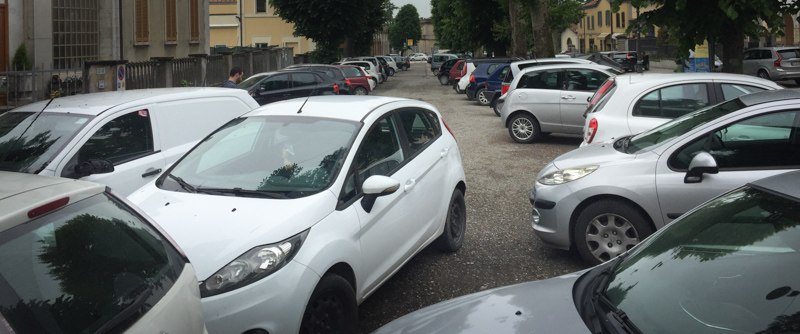
I park, therefore I am
The Tuscans are astoundingly pragmatic about life and I delight in seeing how this pragmatism plays out in daily life. Take the act of parking, for instance, which seems to be elevated to a fundamental right of freedom and self-expression. If there’s a large section of pavement across from your favorite bar, which happens to be a striped traffic island, who says it can’t also be a perfectly good place to park? After all, no one is supposed to be driving there, anyway, and a traffic island is a waste of good real estate.
As an overall rule, the lines painted on the pavement of parking lots are only vague suggestions of where cars should go, or how many cars fit in the lot. Many, many more can fit in as long as there are good manners and common sense used about never blocking someone in.

There are a number of parking lots I have noticed with no exit. The only way out is to backup the length of the lot, hoping no one is coming in at the same time. This system accommodates more cars in a lot and everyone just works around the inconvenience for this reason.

This is one of my favorite parking moments, for so many reasons. It’s a car from the official driving school (the one John and I took driving lessons from, which is a whole other story…). This parking lot is full, so the driving school instructor decides to park illegally in front of the trash dumpsters. What isn’t in the photo is that there is a huge lot right next to this one that is nearly empty, but you have to pay 70 cents to park there, so clearly it’s much better to ignore the no parking zone and park in front of the dumpster.
But the real story is that all of this somehow works. The driving instructor knows when the trash truck comes by and will need access to the dumpster, and that it is fine to block it for now. The police wouldn’t ticket for the same reason—you can’t really expect someone whose office is opposite and is constantly in and out of their car to park in the pay lot.
About a month after we’d moved to our village I’d parked the car in the square overnight, as we often did. When I returned the next morning I was surprised to find that it was now the only car there, and that the weekly market had sprung up surrounding it. Even more surprising, we hadn’t been ticketed. It turned out the police knew the car of the new Americans in town and cut us some slack because we weren’t yet up to speed on the fine points of village living, like what days the main square is emptied of cars for the market.
I love all of this, and it makes me frustrated when I come back to the U.S. and the rules of parking lots feel rigid, with no opportunity for creativity, common sense, and freedom of expression. In any given parking lot there is so much wasted space because people are parking only between the lines. I see parking opportunities everywhere, just ripe for seizing, if you are willing to break the rules.






No Comments